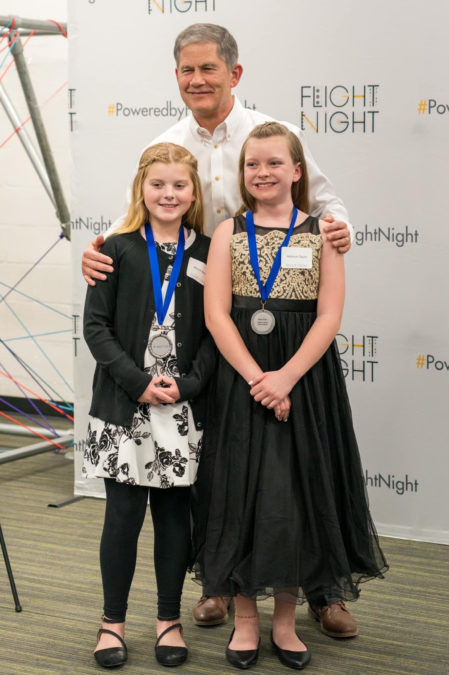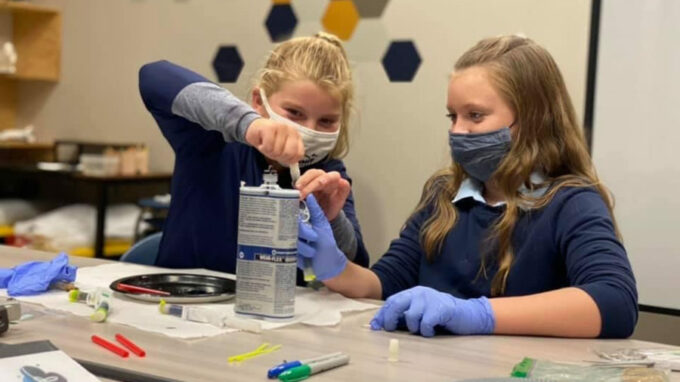As sixth graders, Citizen Potawatomi Nation tribal member Addison Taylor and her science partner Mayzie Burke won the chance to send their experiment to the International Space Station. The two became friends after teaming up in class at Summit Christian Academy in Broken Arrow, Oklahoma.
Their STEAM teacher Stephanie Bradley focuses on curriculum that brings together science, technology, engineering, arts and mathematics. She encouraged her students to enter the annual Tulsa Research Kids competition. In 2019, the Tulsa Regional STEM Alliance worked with the DreamUp organization to offer three Oklahoma teams the opportunity to send their projects to the ISS.
“It was the chance of a lifetime,” Bradley said. “Not many times can you watch students release something into space. We do projects all the time, and sometimes you’re like, ‘OK, put it in the trash.’ And this time, we get to say, ‘OK, put it on a rocket. We’re going to shoot it to space,’ and I’m so glad.”

Port to port
Taylor and Burke both share interests in science and outer space and decided to enter the contest. Taylor’s father works at the Port of Muskogee off the Arkansas River in Muskogee, Oklahoma, where semi-trucks, barges and trains load and unload. One day, they were discussing a product he often uses called WearFlex — a synthetic rubber compound.
“If something goes wrong, he uses WearFlex, and it helps fix cracks, leaks and holes, and tires and belts and all sorts of stuff,” Taylor, a Bertrand family descendant, said.
The students spoke with the company that produces WearFlex to learn the product’s chemical makeup and more. Company representatives supported the duo by attending some of their demonstrations, and they remain in contact today.
She and Burke chose WearFlex for its potential practical application in space. They won several competitions in a row with their idea and advanced to the finals in their age group. After presenting their project for the final time on Dec. 6, 2019, the girls found out they won in January 2020.
Burke looks forward to the chance to see “how (WearFlex) formed in space compared to how it formed down here, to see even if it dried.”

NASA initially scheduled the flight for the summer of 2020; however, the pandemic delayed it several times throughout the year. On Dec. 6, 2020, the experiment launched on a Falcon 9 rocket as part of a service mission to the International Space Station — a full year after the Tulsa Research Kids event.
“When we first found out we’re actually going to space, we were so excited. And then over time, we just got more excited to finally go,” Taylor said.
She, Burke, their families and Bradley all saw the rocket launch at the Kennedy Space Center outside of Orlando, Florida.
“As soon as it actually happened, I was like, ‘Wow, we’re really going!’ because as soon as we drove to the airport, it was hard to believe that we were actually going because of all of the times it got pushed back,” Burke said.
Now in seventh grade, the students enjoy their success but remember the bigger picture.
“We mostly want our project to help astronauts in space,” Taylor said.
Growth on earth
The trip to Florida also marked Burke’s first time on an airplane, a trip to Universal Studios, time at the beach and much more. Due to the launch’s numerous postponements, the group became better acquainted.
“I thought our families kind of (became) like one big family kind of together, even Miss Bradley,” Taylor said.
Bradley and both girls’ parents helped them prepare for each competition, which included repetition of their presentations to improve their public speaking skills. Six judges oversaw the final round and decided whose experiments went to space.
“Whenever we first got up there, at first (I) was nervous,” Burke said. “And then once you just get into it, and then everyone is just used to you. You are used to just talking.”
Practicing helped Taylor as well.
“It felt more calm, like I know what I’m doing and won’t get stumbled up, and … I have Mayzie to help support me,” she said.
Both Bradley and Taylor’s mom, Chanda, felt they watched the duo become more outspoken throughout the year. Taylor somewhat overcame her shyness while learning how to present in front of a panel.
“To see how much these girls have grown, even how their faces have changed. … You can just tell they’re more mature, the way that they speak from beginning to end. They have grown so much. It’s amazing to see,” Bradley said.
Taylor and Burke believe in hard work and positivity.
“You have to use your critical thinking skills to figure out stuff that you can put together that is helpful,” Burke said.
“You can do it anywhere, and even how old you are; you can always think outside the box,” Taylor said. “You can do it, no matter what.”
The girls received their experiment back at the end of January 2021, and it showed positive results for how the substance performed at the space station.
“We hope WearFlex will be a product NASA will purchase and be able to use in the future,” they said.
As they continue their project, their eyes remain on the skies. Taylor hopes to contribute to discoveries in outer space.
“We haven’t explored all of it, and you never know what’s out there,” she said.
To view footage of the rocket launch from Kennedy Space Center from Summit Christian Academy, visit cpn.news/falcon9.

